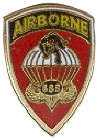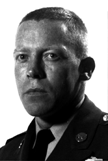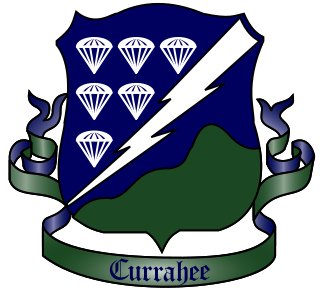
The 82nd Airborne Division is an airborne infantry division of the United States Army specializing in parachute assault operations into denied areas with a U.S. Department of Defense requirement to "respond to crisis contingencies anywhere in the world within 18 hours". Based at Fort Liberty, North Carolina, the 82nd Airborne Division is part of the XVIII Airborne Corps. The 82nd Airborne Division is the U.S. Army's most strategically mobile division.
Operation Golden Pheasant was an emergency deployment of U.S. troops to Honduras in 1988, in response to Nicaraguan attacks on Contra logistics in Honduras.

The 13th Airborne Division was an airborne forces formation of division-size of the United States Army that was active during World War II. The division was commanded for most of its existence by Major General Elbridge G. Chapman. It was officially activated in the United States in August 1943 at Fort Bragg in North Carolina, remaining active until February 1946, however it never saw combat.

The 555th Parachute Infantry Battalion, nicknamed The Triple Nickles, was an all-black airborne unit of the United States Army during World War II.

James Maurice Gavin, sometimes called "Jumpin' Jim" and "the jumping general", was a senior United States Army officer, with the rank of lieutenant general, who was the third Commanding General (CG) of the 82nd Airborne Division during World War II. During the war, he was often referred to as "The Jumping General" because of his practice of taking part in combat jumps with the paratroopers under his command; he was the only American general officer to make four combat jumps in the war.

In military organizations, a pathfinder is a specialized soldier inserted or dropped into place in order to set up and operate drop zones, pickup zones, and helicopter landing sites for airborne operations, air resupply operations, or other air operations in support of the ground unit commander. Pathfinders first appeared in World War II, and continue to serve an important role in today's modern armed forces, providing commanders with the option of flexibly employing air assets. There were a group of pilots who were also designated pathfinders. They flew C-47 (DC-3) aircraft and were the lead planes followed by paratroop transports, used for dropping paratroopers into designate drop zones such as on D day, the Normandy Invasion.

A Walk in the Sun is a 1945 American war film based on the novel by Harry Brown, who was a writer for Yank, the Army Weekly based in England. The book was serialized in Liberty Magazine in October 1944.

The Brécourt Manor Assault during the U.S. parachute assault of the Normandy Invasion of World War II is often cited as a classic example of small-unit tactics and leadership in overcoming a larger enemy force.

The Paramarines was a short-lived specialized combat unit of the United States Marine Corps, trained to be paratroopers dropped from planes by parachute. Marine parachute training which began in New Jersey in October 1940 ended with the parachute units being disbanded at Camp Pendleton, California in February 1944. Paratroopers received a significantly increased salary after completing training, so there was no shortage of volunteers, although all were required to be unmarried. Standards of fitness were high, and 40% failed the training course.

The United States Army Airborne School—widely known as Jump School—conducts the basic paratrooper training for the United States Armed Forces. It is operated by the 1st Battalion (Airborne), 507th Infantry, United States Army Infantry School, Fort Moore, Georgia. The Airborne School conducts the Basic Airborne Course, which is open to troops from all branches of the United States Department of Defense, Reserve Officer Training Corps, and allied military personnel.

Allan Jay Kellogg Jr. is a retired sergeant major in the United States Marine Corps. He received the United States military's highest decoration, the Medal of Honor, for his actions as a staff sergeant on March 11, 1970, during the Vietnam War.

Joe Ronnie Hooper was an American who served in both the United States Navy and United States Army where he finished his career there as a captain. He earned the Medal of Honor while serving as an army staff sergeant on February 21, 1968, during the Vietnam War. He was one of the most decorated U.S. soldiers of the war and was wounded in action eight times.

The 505th Parachute Infantry Regiment, originally the 505th Infantry Regiment, is an airborne infantry regiment of the United States Army, one of four infantry regiments of the 82nd Airborne Division of the United States Army, with a long and distinguished history.

The 504th Infantry Regiment, originally the 504th Parachute Infantry Regiment, is an airborne forces regiment of the United States Army, part of the 82nd Airborne Division, with a long and distinguished history. The regiment was first formed in mid-1942 during World War II as part of the 82nd Airborne Division and saw service in Sicily, Italy, Anzio, the Netherlands, Belgium and Germany.

E Company, 2nd Battalion of the 506th Parachute Infantry Regiment of the 101st Airborne Division, the "Screaming Eagles", is a company in the United States Army. The company was referred to as "Easy" after the radio call for "E" in the phonetic alphabet used during World War II. The experiences of its members during that war are the subject of the 1992 book Band of Brothers by historian Stephen Ambrose and the 2001 HBO miniseries of the same name.

The 501st Infantry Regiment, previously the 501st Parachute Infantry Regiment and 501st Airborne Infantry Regiment, is an airborne forces regiment of the United States Army with a long history, having served in World War II and the Vietnam War, both as part of the 101st Airborne Division, as well as the War in Afghanistan. It is the first airborne unit by designation in the United States Armed Forces. Its 1st Battalion is assigned to the 2nd Infantry Brigade Combat Team (Airborne), 11th Airborne Division, located at Fort Richardson, Alaska. Its 2nd Battalion is assigned to the 1st Brigade Combat Team, 82nd Airborne Division, located at Fort Liberty, North Carolina.
Mission Boston was a parachute combat assault at night by Major General Matthew Ridgway's U.S. 82nd Airborne Division on June 6, 1944, part of the American airborne landings in Normandy during World War II. Boston was a component element of Operation Neptune, the assault portion of the Allied invasion of Normandy, codenamed Operation Overlord. 6,420 paratroopers jumped from nearly 370 C-47 Skytrain troop carrier aircraft into an intended objective area of roughly 10 square miles (26 km2) located on either side of the Merderet river on the Cotentin Peninsula of France, five hours ahead of the D-Day landings.

First Sergeant Leonard Alfred Funk Jr. was a United States Army Medal of Honor recipient and one of the most decorated soldiers and paratroopers of World War II. While serving with the 508th Parachute Infantry Regiment, then part of the 82nd Airborne Division, he also received the Distinguished Service Cross, Silver Star, Bronze Star Medal, and three Purple Hearts.

Brigadier General William Thomas Ryder was an officer of the United States Army and the first American paratrooper during World War II. Ryder helped pioneer Army airborne training, equipment and tactics alongside men like Jim Gavin, William Yarborough, Bill Lee, Art Gorham and Bud Miley. He was an aide to General of the Army Douglas MacArthur from 1944 until 1951. In the early 1960s he was a top Army expert in guided missile systems, retiring as a brigadier general in 1966.
Screaming Eagles is a 1956 American war film directed by Charles F. Haasd starring Tom Tryon, Jan Merlin and, in her film debut, French Miss Universe 1954 runner-up Jacqueline Beer. It was released by Allied Artists.


















